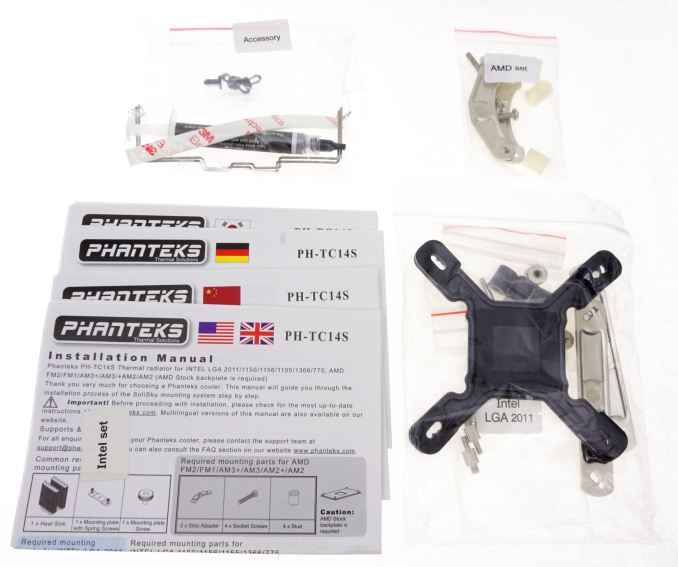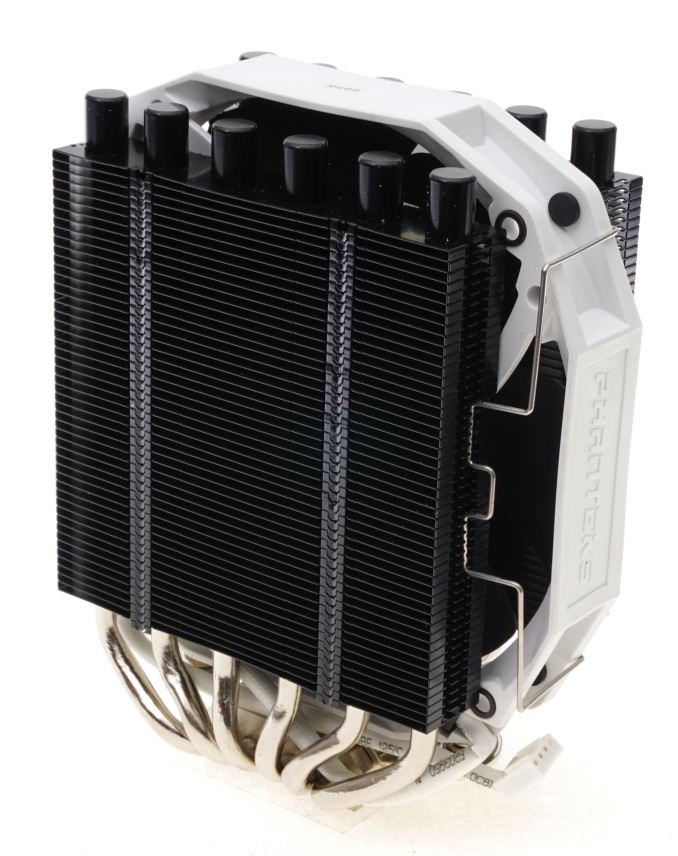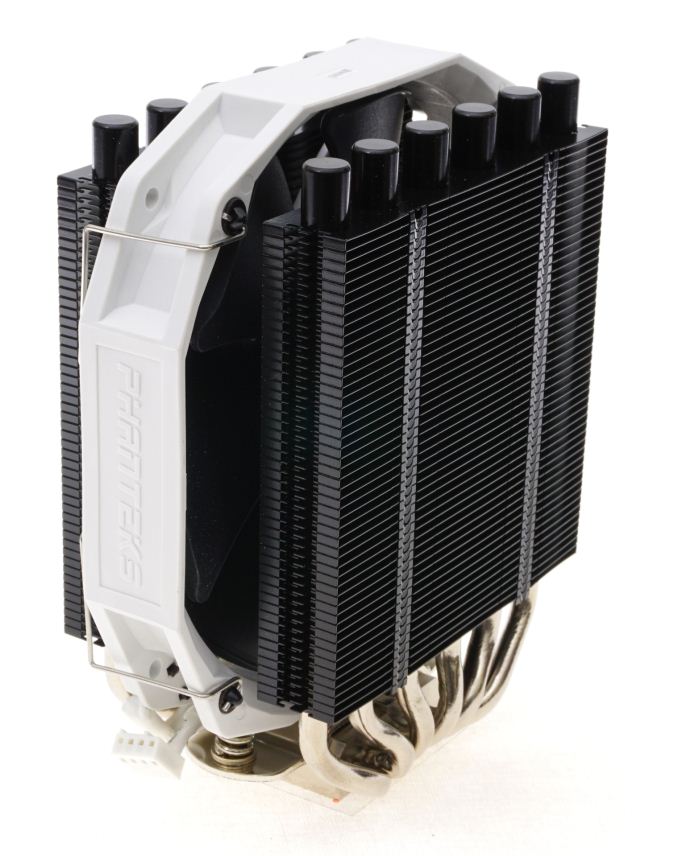The 140mm Slim Tower CPU Cooler Roundup: Thin & Light Done Just Right
by E. Fylladitakis on May 24, 2017 8:00 AM EST- Posted in
- Cases/Cooling/PSUs
- be quiet!
- Noctua
- Phanteks
- Cooler
- Thermalright
Phanteks PH-TC14S
Phanteks supplies the PH-TC14S inside a dark cardboard box with an abstract aesthetic theme, mostly based on schematic drawings of the cooler itself. It is not a very large box for a cooler that size, but it is very sturdy and the cooler is protected with polystyrene foam packaging, making it nearly impossible to damage during transport.
Inside the box we found four manuals, one for each of the most popular languages in the regions that the cooler is being marketed into, the necessary mounting hardware and a syringe with Phanteks PH-NDC thermal compound that should last for at least a couple of applications.
The Phanteks PH-TC14S is the “cheater” of this review, as it is not a single tower but a dual tower cooler design. It technically is a baby version of the monstrous PH-TC14PE that we had a look at a couple of years back. Still, this is Phanteks' only slim 140 mm tower cooler offering, and it is of comparable size to every other cooler in this roundup review. What the designers of Phanteks did was to split the single tower array into two very narrow arrays and place the 140 mm fan in between them. Strangely, the fins are significantly smaller than the fan without any apparent reason, meaning that there will be a significant loss of airflow to every direction.
The array fins are very thin and not strong individually, but they are soldered on the thick heatpipes that are only a few millimeters apart from each other. One major feature of the PH-TC14S is its black fins. Phanteks calls this paint job "Physical Antioxidant Thermal Shield" (or Physical Antioxidant Thermal Spraying - we found both in the company's texts) and claims that it enhances thermal performance by both increasing the dissipation rate of the heatsink itself and decreasing the radiation absorption rate from other heat sources. Unlike the PH-TC14PE, the PH-TC14S is available only in black.
The PH-F140HP fan also is a primary marketing focus of this product. It has the lowest RPM rating of every fan in this review (1300 RPM) but impressively high static pressure specifications (1.64 mm H2O at max speed).
Six thick heatpipes expand to either side of the small base. With the fin arrays placed in parallel, each heatpipe enters both arrays. Although that design appears very symmetric and effective at first, it actually does not appear to be optimal, as the two middle heatpipes that will be right above the CPU core and will be facing the bulk of the heat transfer enter near the fin arrays near the middle, where the fan’s airflow will be the lowest due to the dead spot under its motor.
The rectangular copper base of the PH-TC14S and the copper heatpipes are all nickel plated. Like with the majority of modern coolers, the base of the PH-TC14S is made of two parts, a copper contact plate and an aluminum top frame. The lower half of the base handles the thermal energy transfer away from the CPU and to the heatpipes, while the top half only offers mechanical cohesion and support for the steel mounting brackets. The nickel plated base is very smooth and machined down to a near-perfect mirror finish.
















74 Comments
View All Comments
CheapSushi - Thursday, May 25, 2017 - link
I wish there was also a passive test. So we can actually see how that heatsinks on their own performance to gauge the efficiency and quality of the designs themselves. The fans add another variable. Maybe even have a case fan for some airflow. I'd like to see how the heatsink itself does because there can be situations where maybe there is a superior heatsink design here but the company has a poor fan compared to another competitor. The competitors fan could just be superior, thus brute forcing the better temps. How would you really tell? There's no passive test.bug77 - Thursday, May 25, 2017 - link
Hm, why doesn't the article list the weight of these coolers? When they're so large they tend to add quite some torque to the motherboard, so weight should be an important criterion when choosing between these.doyll - Thursday, May 25, 2017 - link
Great testing! TRUE Spirit 140 Direct did exceptionally well for an economy cooler. Would be interesting to see how the TRUE Spirit 140 Power, Archon IB-E X2 and some of the other Thermalright coolers. The PH-TC14S definitely is not a great cooler.fanofanand - Thursday, May 25, 2017 - link
The fact you threw in the Wraith cooler makes me sooooo happy! I was hemming and hawing between 1600 and 1600x with the free cooler thrown in being a nice boost for the 1600. Seeing that the better coolers show a pronounced improvement in most cases tells me that free cooler shouldn't be the decider.Peichen - Thursday, May 25, 2017 - link
Thermalright is like Cooler Master, simple design that reduce cost but performs well. People that have been OCing for the last 20 years know Thermalright's design is usually test provenLeyawiin - Thursday, May 25, 2017 - link
I own two of the original (smooth surface) Thermalright True Spirit 140. Its a very good cooler in many respects save for the fan mounting system. They have the most weak, fiddly wire fan mounts I've ever seen. Plus the rubber anti-vibration pads they were using back then simply won't stay on. I decided with later builds to use Noctua in subsequent builds and even though they're about a quarter to a third more expensive its worth it just for their great mounting system. Plus they regularly send me emails to remind me that all my coolers from them are eligible for free mounting hardware for new sockets. No other company that I know of does that.azrael- - Monday, May 29, 2017 - link
I think that one important aspect of any cooler review should be the *weight* of the cooler.Considering that in most system configurations the motherboard is mounted vertically and coolers are hanging off the motherboard, you really don't want them to be too heavy. Even though the cooler may be securely attached to the motherboard the heavier it is the more stress it exerts on the motherboard. Preferably, I don't want mine to weigh much in excess of 500g.
azrael- - Monday, May 29, 2017 - link
I think that one important aspect of any cooler review should be the *weight* of the cooler.Considering that in most system configurations the motherboard is mounted vertically and coolers are hanging off the motherboard, you really don't want them to be too heavy. Even though the cooler may be securely attached to the motherboard the heavier it is the more stress it exerts on the motherboard. Preferably, I don't want mine to weigh much in excess of 500g.
darkbreeze - Friday, February 21, 2020 - link
Quote - Nevertheless, the thermal performance of the NH-U14S is significantly superior as well, especially when the cooler needs to handle a high thermal load.Yes, I realize this thread is three years old, however, having come across it I couldn't let that blatantly wrong observation from the review go uncontested when the reviews own results CLEARLY show the Thermalright True Spirit Direct 140 having a lower overall rise over ambient than any of the other three coolers.
How do you figure the Noctua has better performance if your own results show that the Thermalright does? Why did NOBODY notice that, and comment on it?
If Crashman or Garrett over at TH had done that, they'd have been ripped to pieces.
Oxford Guy - Tuesday, January 4, 2022 - link
I just read TH’s Best Coolers for 2022 article and the first one in the list is a Cooler Master that fails against the competition in every metric, according to the data in the site’s own reviews.